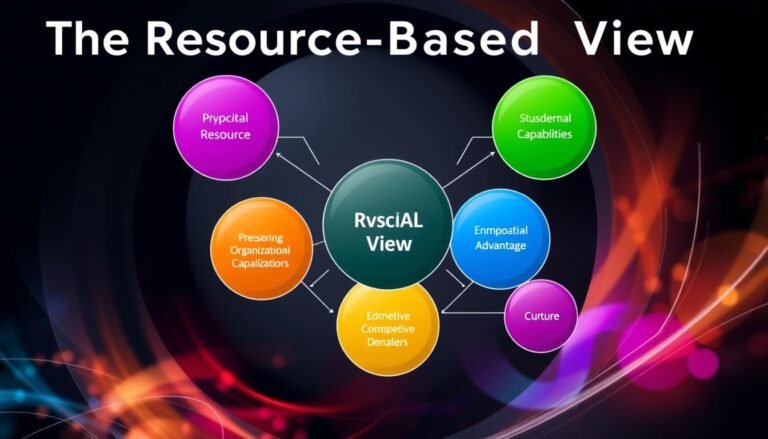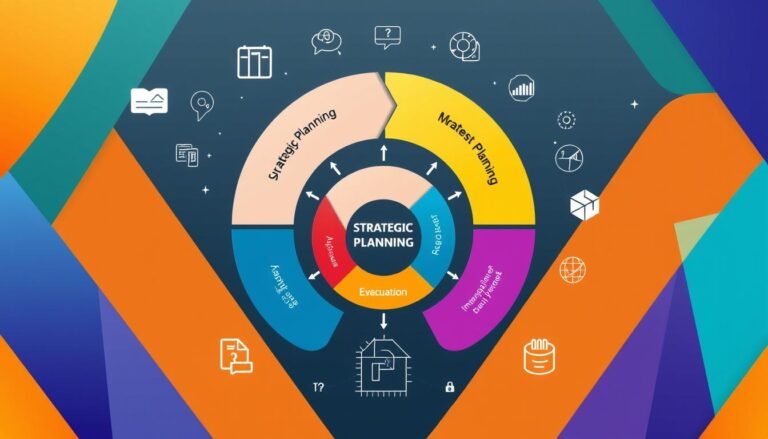Mastering Break-Even Analysis for Business Success
Have you ever wondered why some businesses do well while others don’t, even if they offer similar products? The key might be in their grasp of break-even analysis. This financial strategy shows when revenue equals expenses, leading to profits. By understanding break-even analysis, business leaders can make smart choices about pricing, sales goals, and managing costs. This leads to business success.
In today’s competitive world, knowing when you’ll start making profit is key. Break-even analysis shows the balance between fixed and variable costs. It helps businesses find their break-even point. This insight is crucial for seeing profit potential at different sales levels and is key for planning a business.
Key Takeaways
- Break-even analysis helps determine when revenue equals expenses, which is vital for profit evaluation.
- The break-even point shows the sales level needed to cover all costs and start making profits.
- Knowing about fixed and variable costs is key for setting prices and planning finances.
- This analysis is a powerful tool for new ventures to check if their business ideas work.
- Break-even analysis is important for risk assessment, helping businesses make smart choices.
- Using break-even analysis well can improve financial forecasting and overall business success.
Understanding Break-Even Analysis
Break-even analysis is key in financial planning and management. It helps businesses find out when they make neither profit nor loss. This happens when total revenue equals total costs. Knowing this point is vital for checking if a business can make it.
Definition and Importance
Break-even analysis is more than just about seeing profit chances. It helps businesses make smart choices on pricing, sales, and costs. Knowing where a business is at its break-even point helps it deal with market changes and stay profitable.
Key Components of Break-Even Analysis
Key parts of break-even analysis include:
- Fixed Costs: These are costs that don’t change with production levels, like rent and salaries.
- Variable Costs: These costs change with how much is produced, like materials and labor.
- Contribution Margin: This is the difference between what you sell something for and what it costs to make it. It’s key to finding the break-even point.
Knowing these parts helps businesses plan better. The contribution margin is crucial in figuring out the break-even point. This can be found using a simple formula:
| Break-Even Point Calculation | Formula |
|---|---|
| Total Fixed Costs | Fixed Costs / (Sales Price per Unit – Variable Cost Per Unit) |
| Break-Even Point in Units | Total Fixed Costs / Contribution Margin |
Break-even analysis helps set financial goals and understand what sales are needed for profit. It shows how changing prices or costs affects the business’s financial health. This makes it a key tool for planning and analyzing a business.
Defining the Break-Even Point
The break-even point is key for businesses. It’s when what a company makes equals what it spends. Knowing this helps companies see if they’re making money or not. It also helps them set sales goals and decide on prices.
What Constitutes the Break-Even Point?
The break-even point is when a company’s income matches its costs. It tells you how many items you need to sell. It’s also important for making big decisions.
At this point, a company doesn’t make a profit or lose money. It’s a key way to check how well a business is doing.
Importance of Identifying the Break-Even Point
Knowing the break-even point helps businesses understand their money better. It helps set sales targets and check pricing strategies. It also helps plan finances better.
For example, if a company finds it needs to sell 6,250 units to break even, it can plan better. This way, it can aim to sell more and make more money.
| Component | Description | Impact on Break-Even Point |
|---|---|---|
| Fixed Costs | Your business’s ongoing expenses that do not change regardless of production levels. | Higher fixed costs increase the break-even point. |
| Variable Costs | Costs that vary directly with production volume. | Lower variable costs decrease the break-even point. |
| Selling Price | The amount charged to customers for each unit of product sold. | Higher selling prices reduce the number of units needed to break even. |
| Contribution Margin | Calculated as selling price minus variable cost. | A higher contribution margin leads to a lower break-even point. |
The Process of Calculating Break-Even Point
Understanding how to calculate the break-even point is key for good business management. It helps companies check their financial health and find out how much they need to sell to cover costs. Fixed and variable costs are key to this calculation.
Fixed Costs vs. Variable Costs
Fixed costs stay the same, no matter how much you produce. Examples include:
- Rent
- Salaries
- Insurance
- Utilities
Variable costs change with how much you make or provide. These include:
- Materials
- Labor costs
- Advertising
Knowing the difference between these costs is crucial for figuring out the break-even point. It helps in making smart financial choices.
Using the Break-Even Formula
The break-even formula is: Break-Even Point (Units) = Fixed Costs / (Selling Price per Unit – Variable Cost per Unit). This helps businesses see how many sales they need to make to cover all costs. For instance, a company with $10,000 in fixed costs and a $80 profit per unit must sell about 125 units to break even.
Let’s say a company has $60,000 in fixed costs, $15 in variable costs per unit, and sells for $30. We can figure out the break-even revenue:
| Item | Value |
|---|---|
| Fixed Costs | $60,000 |
| Variable Cost per Unit | $15 |
| Selling Price per Unit | $30 |
| Break-Even Revenue | $60,000 |
This method helps businesses set smart prices and find out how much they need to sell. By understanding the break-even point, companies can use their resources better and increase profits.
Application of Break-Even Analysis in Business Planning
Using break-even analysis in business planning is key. It helps set up effective sales targets and pricing strategies. This tool shows how much sales are needed to cover costs. It guides companies toward their financial goals.
Setting Sales Targets and Pricing Strategies
Break-even analysis helps set realistic sales targets by showing the minimum needed to avoid losses. It helps businesses understand the costs and set prices that match market demand.
- Sales Targets: Companies can set realistic sales goals by figuring out the break-even point. For instance, a firm with $20,000 in fixed costs and a 35% gross margin needs $57,143 in sales to break even.
- Pricing Strategies: By looking at costs, firms can find the best prices that make profits and stay competitive.
This method improves decision-making and gives a clear financial plan for new and growing businesses. Companies can use break-even analysis to adjust their prices, check profits, and adapt to market changes.
Analyzing Fixed Costs and Their Role
Understanding fixed costs is key for any business wanting to stay financially stable. These costs are vital in figuring out when a business will break even. They also affect how well a business does financially. By looking closely at these costs, companies can make smart choices to better manage their budgets.
Different Types of Fixed Costs
Fixed costs include several important types, such as:
- Rent
- Salaries
- Insurance
- Equipment depreciation
- Utilities
- Advertising expenses
Knowing what these costs are helps businesses plan better. They make sure they have enough money set aside for these necessary expenses.
Impact of Fixed Costs on Break-Even Calculation
Fixed costs are crucial in figuring out the break-even point. This is the point where a business stops losing money. If fixed costs go up, a business needs to sell more to start making a profit. For instance, Hicks Manufacturing had $18,000 in fixed costs. They had to sell 225 units to start making money.
The break-even point is found using this formula:
Break-even point (Units) = Fixed Costs ÷ (Revenue per Unit – Variable Cost per Unit)
Looking closely at fixed costs helps companies set their prices right and manage their costs better. Cutting unnecessary costs or making them more efficient can boost profits.
Managing fixed costs well helps companies make better decisions. It helps them plan for growth and set realistic sales goals. Through break-even analysis, companies can check if new products will work out. They can also adjust their plans to do better financially.
| Type of Fixed Cost | Examples | Typical Monthly Expenses |
|---|---|---|
| Rent | Office space, warehouse | $2,500 |
| Salaries | Employee wages, administrative salaries | $10,000 |
| Insurance | Liability, property, health insurance | $1,200 |
| Equipment Depreciation | Machinery, vehicles | $1,000 |
| Utilities | Electricity, water, gas | $800 |
| Advertising | Marketing campaigns | $1,500 |
Understanding fixed costs and their role in break-even analysis helps businesses make smart decisions. This can improve their financial performance.
Understanding Variable Costs in Break-Even Analysis
Variable costs are key to a company’s financial health. They change with how much a company produces. These costs include things like raw materials, labor, and shipping. Knowing these costs is vital for planning, as it helps figure out the total cost and profit.
Calculation of Variable Costs
The cost of making something changes with how much you make. For instance, a bakery might spend $5 on materials and $20 on labor for each cake. They sell each cake for $30. Knowing these costs helps set prices right and make more money.
This is important because it helps figure out when the company will make no profit or loss. It’s all about knowing the costs and how they change with sales.
Influence of Variable Costs on Profitability
Variable costs are key to making money. Cutting these costs can make more profit and lower the sales needed to break even. Companies with more variable costs see less change in profits, as profits depend on sales.
Understanding these costs helps with budgeting and planning. It lets companies grow and work better.
Source Links
- Master the Break Even Analysis: Ultimate Guide
- Master the Break Even Analysis: The Ultimate Guide – Shopify
- Detailed Analysis of Break-Even Point with Formula & Examples
- Break-Even Analysis: Formula and Calculation
- Break Even Analysis
- Break-even point | U.S. Small Business Administration
- Breakeven Point: Definition, Examples, and How to Calculate
- Break-Even Analysis | Definition, Calculation, Pros & Cons
- Break Even Point (BEP)
- Pricing
- How to Apply Break-Even Analysis to Your Business – business.com
- Break-Even Analysis Explained—How to Find the Break-Even Point – LivePlan
- Break-Even Analysis 101: How to Calculate BEP and Apply It to Your Business
- 7.2 Breakeven Analysis
- Variable Cost: What It Is and How to Calculate It
- Variable Costs







